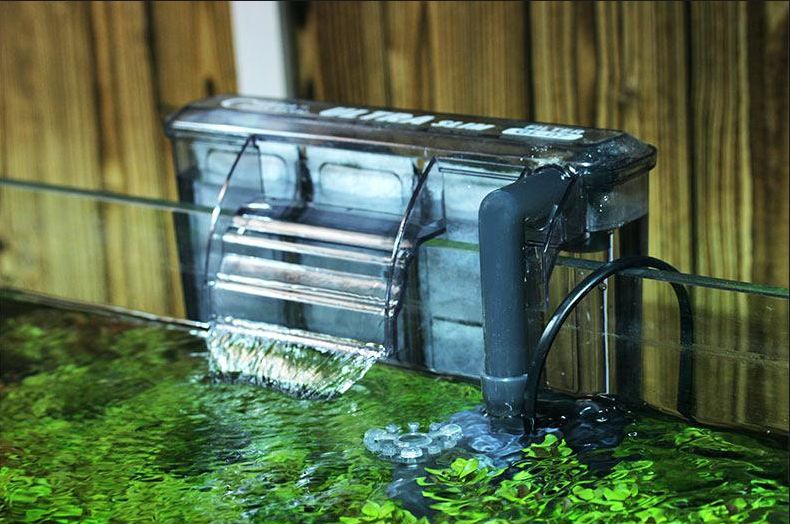
There are many types of filters which use a box hung off the back of the aquarium to mechanically filter the waste. These are called hang-on-back, HOB or cartridge filters. They range from $20 to $90. They are probably the most common filter.
Most HOB filters move the water from one side (the side away from the aquarium) of the hanging box to the other side (the side closest to the aquarium) of the HOB through a “cartridge”. This is a “back-to-front” flow HOB cartridge filter. There are also some in-tank cartridge filters that come with small ten gallon aquarium kits which work exactly the same as hang-on-back cartridge filters.
Most hang-on-back (HOB) filters typically come with “cartridges”, plastic frames covered in polyester floss and filled with activated carbon. The manufacturer (Marineland Penguin, Aqueon Quietflow, Top Fin, Tetra Whisper, etc.) recommends changing these out with new ones every month or so.
.
Replacing cartridges every month is a huge rip-off which creates very bad conditions for the fish.
.
Replacing cartridges makes obscene profits for the filter manufacturer and removes virtually all the beneficial bacteria which are needed for ammonia oxidation. Cartridges and media last for many years and shouldn’t be replaced till they start falling apart. Just clean the brown gunk off the outside of the cartridge when the flow noticeably slows down. Use a small brush to do this in a tub of water. Never put the cartridge under running water.
Note that we have become aware that some cartridge manufacturers like Top Fin have started using what is called a “biodegradable binder” in the manufacture of their cartridges. The white polyester covers of their cartridges literally start falling apart after only a month or two in water. One MUST replace these cartridges with foam or pot scrubbers per the directions below.
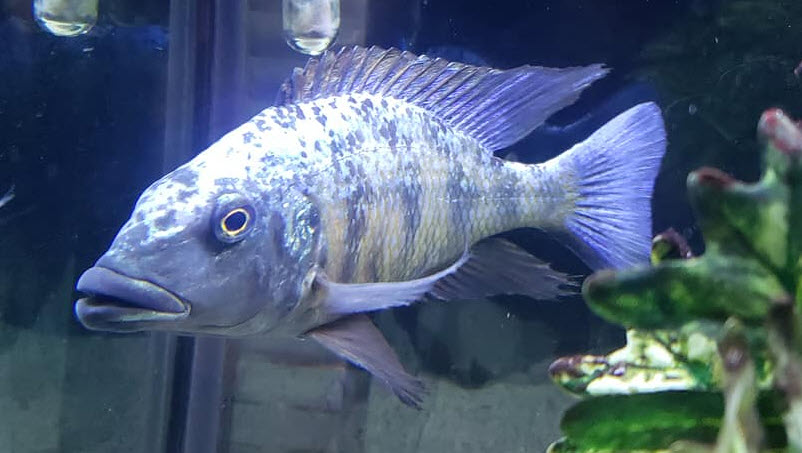
There are three types of cartridge media:
- Mechanical: this is typically a polyester bag but it is a foam in one HOB (Aqua-Clear). Both the polyester bag and the foam will last for years and only need rinsing when they plug up.
- Biological filtration: This is done with bioballs and ceramic rings in some, it is absent in others. The activated carbon in most cartridges will act as a decent biofilter after a few weeks of operation.
- Chemical Filtration: there is no chemical filtration needed in ANY aquarium, so replacing this or even using it is pretty pointless. Carbon should just be left in place to act as a biomedia.
These “back-to-front” flow HOB filters do an excellent job of mechanical filtration and it is easy to remove the mechanical filter cartridge and clean it when it plugs. If you want to keep the cartridges in a cartridge filter use a brush to remove the brown gunk from the face of the cartridge to clean.
The activated carbon in the cartridge functions as a chemical filtration media for all of about two weeks. Since there is no need for chemical filtration in most aquariums (carbon only removes colored materials such as the tannins which come from some woods) the activated carbon should just be left in place undisturbed to act as a biofiltration media, a place where beneficial bacteria can grow.
The flow from back-to-front HOB filters just can’t hold a lot of biomedia in their cartridges and bags, maybe half an ounce at most. That just not enough to do good biofiltration. Such a filter should be supplemented with another filter with a large volume of biomedia.
Note that only very small amounts of biofiltration are needed to do ammonia removal while much larger amounts of biofiltration (ten to twenty time more!) are needed for crystal clear water, bacteria free water and healthy fish. So hang-on-back filters will give good ammonia oxidation. They will not give crystal clear, healthy water.
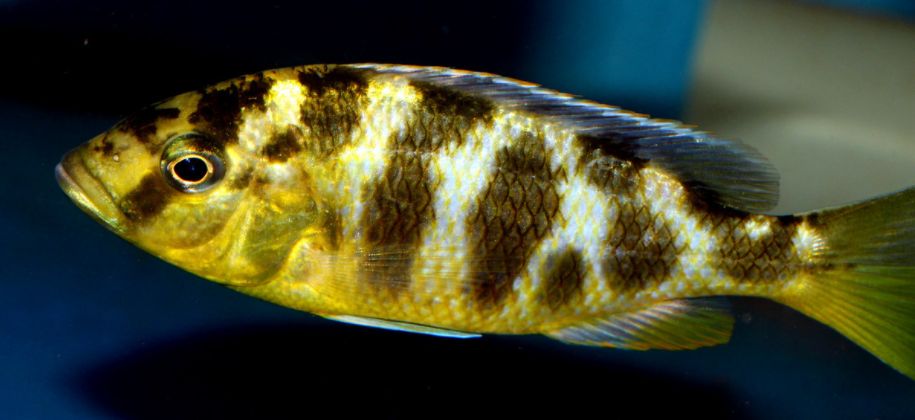
Downsides to Hang-on-back Filters
HOB filters are far less of a biofilter than any under-gravel filter or sponge filter and cost more. They just have too little of biomedia and they require frequent cleaning. When they are cleaned the beneficial bacteria can easily be removed and what little biofiltration capacity the HOB has goes down the drain with the rinse water.
If you must keep the cartridges do nothing to the media inside the cartridge (typically activated carbon). The brown gunk which builds up in the media is beneficial bacteria, not fish poop. This media brown gunk is good for your fish and needs to be preserved.
To clean a cartridge simply brush the accumulated brown gunk off the surface of the cartridge with a small brush. This will restore good flow without compromising the beneficial bacteria.
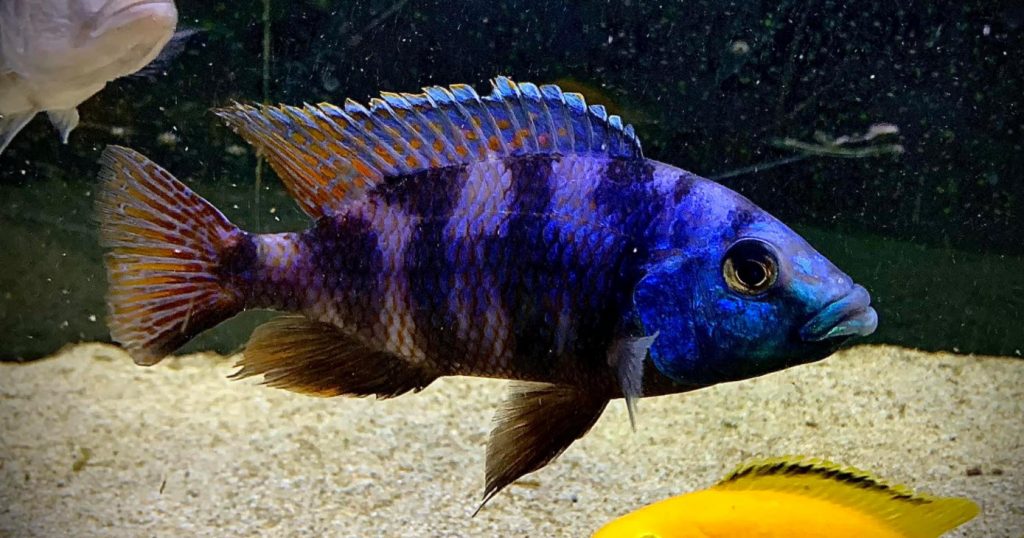
Adding to Hang-on-back Filters
If one is limited to a hang-on-back filter for any reason, add an under-gravel filter or a sponge filter to give biofiltration. Just be sure to not clean the sponge filters or under-gravel filters but very lightly and very infrequently,. like once every four months to six months for a sponge filter and two years to never for under-gravel filters.
Under-gravel filters have suffered a lot of totally undeserved bad press created by manufacturers of expensive canister filters. Isn’t the profit motive great? If cleaned frequently under-gravel filters are a huge pain in the butt and they don’t work well as a biofilter. But under-gravel filters are a very good biofilter if they are only cleaned every few years. If powerheads are used to drive them they become even better. Here is a link to understanding under-gravel filters:
8.5. Under-Gravel Filters
One can also add an excellent small canister filter which is only about $40 over the internet. This is the Sunsun HW-603B 106 GPH 3-Stage External Canister Filter. This small filter has about 64 cubic inches of foam, which is the equivalent of a sponge filter with a powerhead. Unlike a sponge filter it can be hidden below the aquarium out of sight. It will give excellent biofiltration if the instructions to change the foam every four months are ignored.
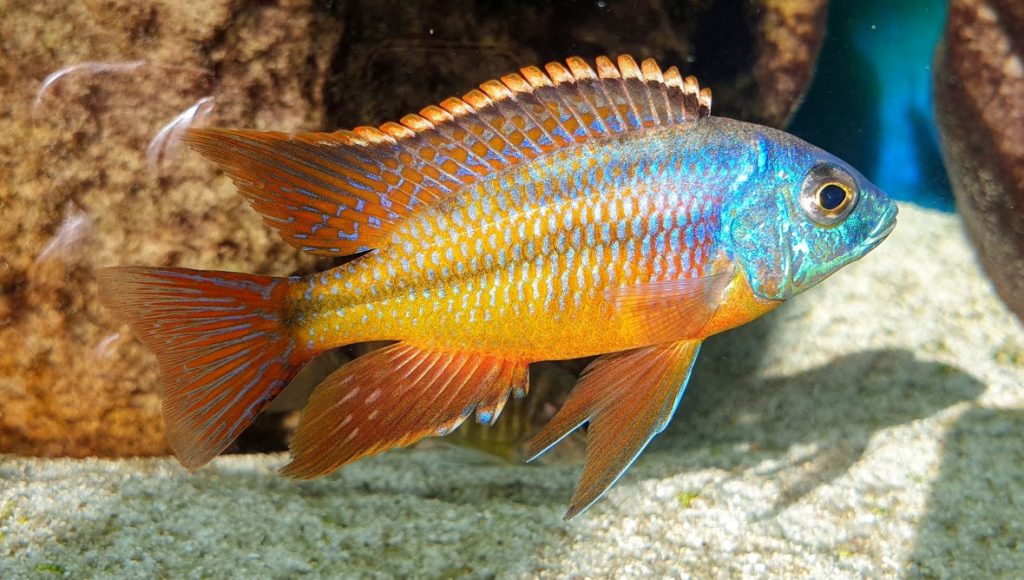
Cory’s Recommendations
To improve a hang on back filter Cory at Aquarium Co-op (by far the best most honest “guru” in the business) recommends replacing the cartridge with foam. Then lightly clean the foam when the flow through it slows down noticeably. Simply squeeze the sponge no more than twice in a bucket of water.
Cory’s has an excellent YouTube video on how to get the best bang for your buck on HOB filters (this is simply the best aquarium YouTube channel out there). Cory recommends two basic things to do with hang-on-back filters to optimize them:
- Take out the cartridges and the baskets and replace them with 20 ppi to 30 ppi foam blocks.
- Add a foam piece to the intake of the hang-on-back filter.
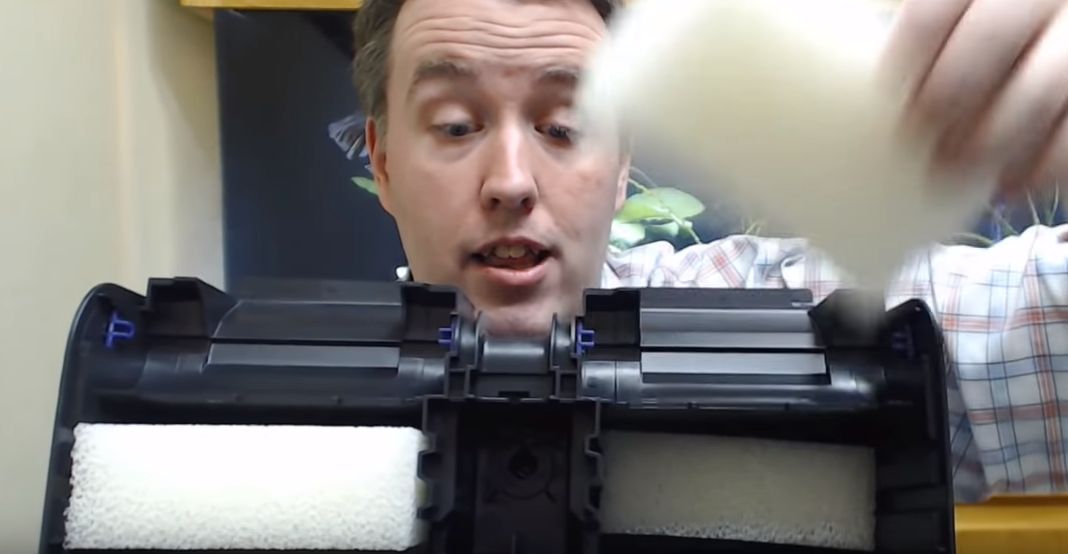
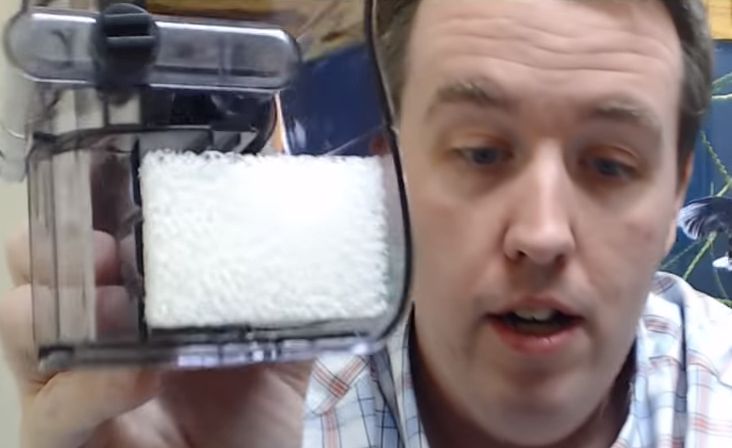
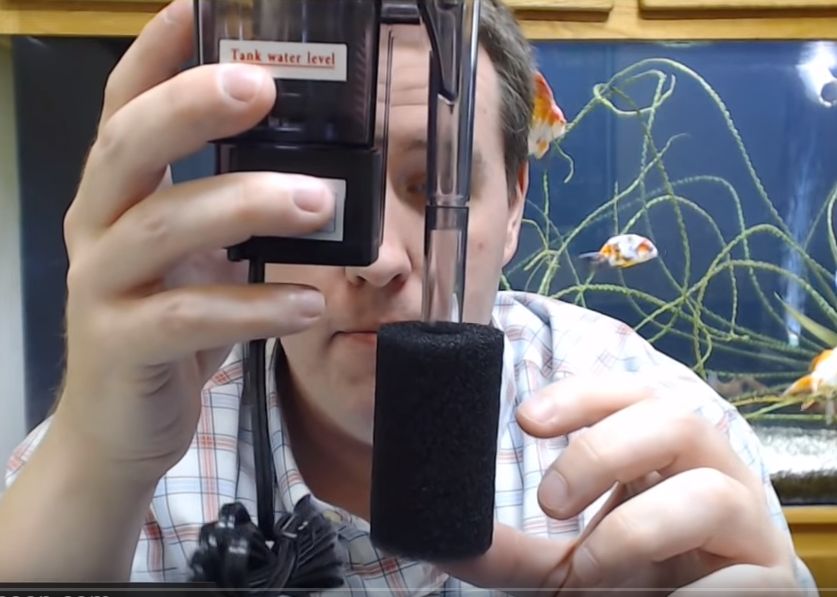
.
If a hobbyist makes this switch on an established cartridge filter, it is important to “seed” the new foam. Thoroughly rinse the old dirty cartridge in a couple of cups of water (tap water is fine). Pour the resulting brown soup into the new filter set up on the tank. The brown gunk is the beneficial bacteria.
Now there are some important details about Cory’s way of improving hang-on-back filters. First is that the back-to-front flow hang-on-backs MUST have at least a quarter inch of free space behind the foam inserts. This free space lets the water flow over the face of the whole sponge insert.
The second point is that the foam intake sponge MUST be a 20 ppi (pores per inch) foam. The pump on a cartridge hang-on-back isn’t very strong so a 30 ppi foam plugs up too fast.
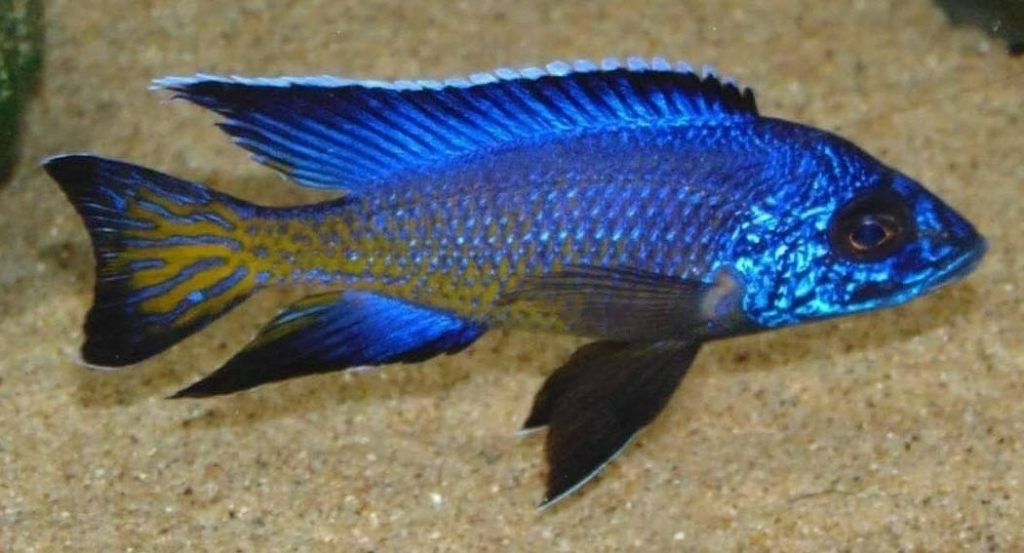
Also with a pre-filter the rate at which it plugs up depends on the fish load and food load. If you only have three or four three inch fish a sponge pre-filter can handle it. If you have nine or ten four inch fish it won’t handle the load. It also depends on feeding. If you feed 1% of the fish’s weight you might be fine. If you feed 3% of a fish’s weight you’ll be in trouble.
Also both pieces of foam will plug fairly quickly even at 20 ppi with any sort of decent aquariums stocking. A decently stocked tank needs the foam squeezed TWICE and only TWICE in a bucket of water once every week to two weeks. Squeezing more than twice removes too much beneficial bacteria.
Also understand that Cory’s modifications do NOT make hang-on-back filters good bio-filters. They only make a bad situation a decent situation.
A Better Alternative to Foam
Plastic pot scrubbers are better than foam in hang on back filters.
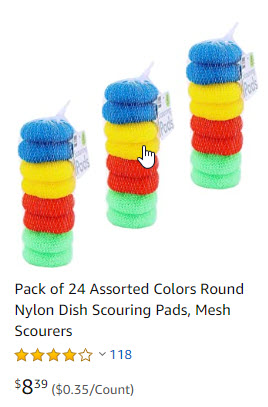
Testing of media has shown round brightly colored plastic pot scrubbers to be close to foam as far as the biofiltration capacity. And the pot scrubbers don’t plug as easily as foam. So the entire back of a hang-on-back filter compartment can be stuffed with plastic pot scrubbers and one will get a very decent HOB, at least as far as HOBs go.
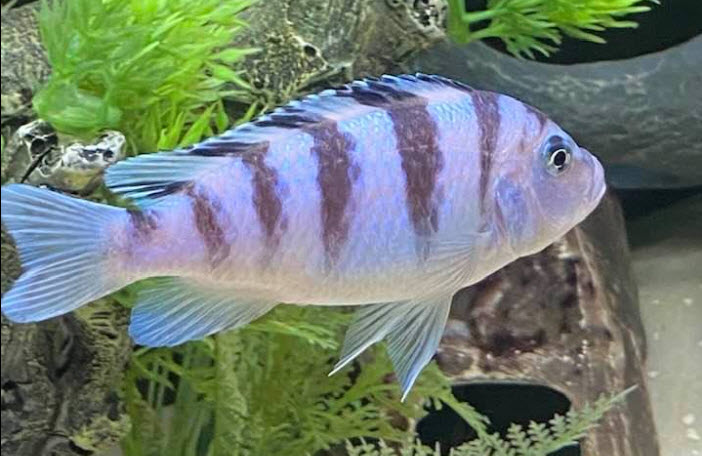
Bottom Flow Hang-on-back Filters
There is one type of HOB filter which is unique. The two currently sold are the Seachem Tidal™ Power Filters and the Hagen Fluval/AquaClear Power Filters. These are relatively large HOBs that flow from the bottom of the filter up. They are more like small canisters than HOBs in their properties. They CAN do decent biofiltration because they hold a decent amount of biomedia, AS LONG AS THE PROPER MEDIA IS USED AND IT ISN’T CLEANED VERY OFTEN.
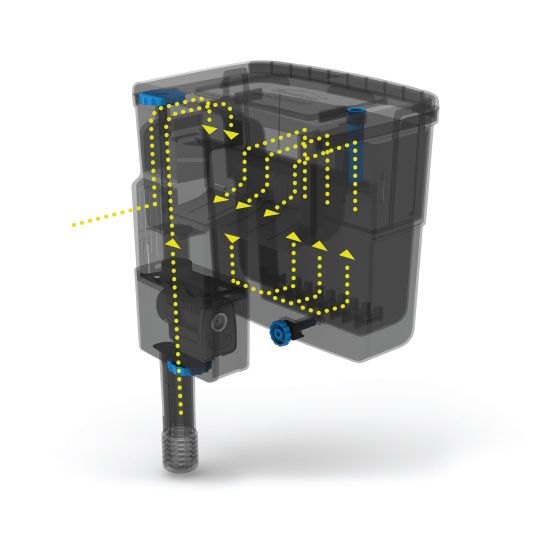
These bottom to top flow filters have the same limitation as canisters and sumps in that they are very dependent on the filter media they are loaded with. A bottom to top flow HOB loaded with foam, pot scrubbers or static K1 media will filter five times the bioload of the same filter filled with ceramic rings, Matrix, Biohome or lava rock.
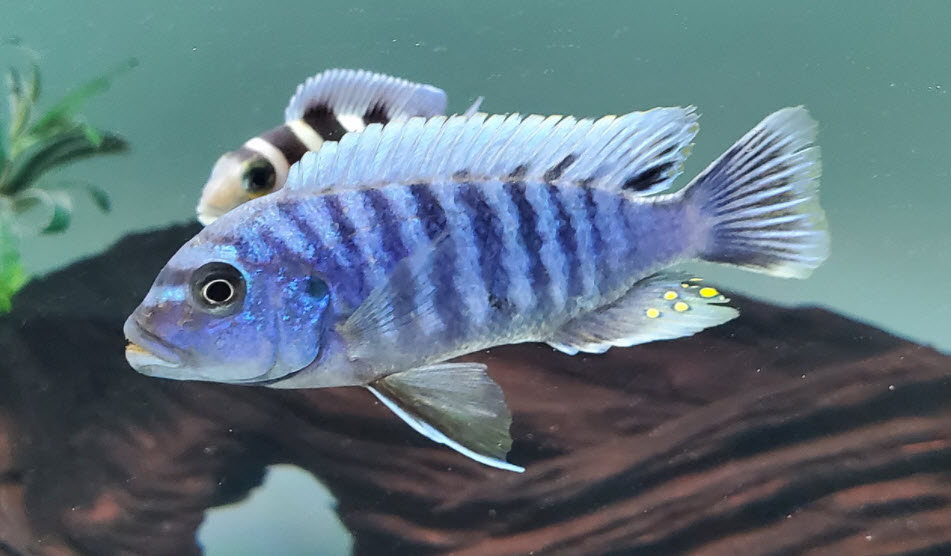
For more on how biomedia stack up go to this link:
7.1.3. Test of Filter Media
Note that the Fluval/Aqua-Clear hang-on-back bottom to top flow filter has an interesting way of making a huge profit. They recommend replacing bags of media in each of the three trays every month, two months and three months. This is a totally unnecessary replacement which just makes money for them.
While these bottom to top flow hang-on-back filters are an improvement over the cartridge hang-on-back filters they are still not very good bio-filters. For light stocking they would be fine but any decent stocking would require a filter with more bio-media capacity (i.e. a canister, under-gravel or sump filter).
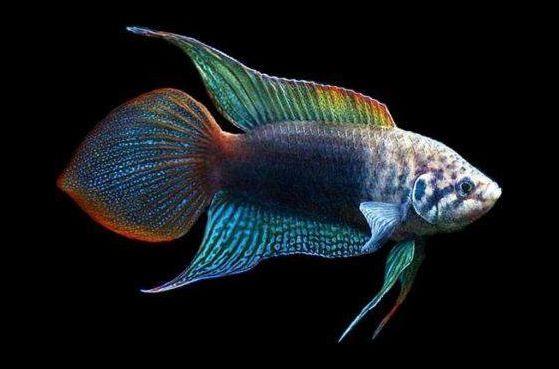
Aeration from a Hang-on-back Filter
Most HOB filters put the water into the aquarium in a smooth flowing downward sheet. This gives poor aeration. Most of the bottom to top flow hang-on-back filters use a curved lip on their outlet which puts the water out parallel to the surface of the aquarium. These can do decent aeration.
Making a HOB a Fluidized Bed
A good option for the largest bottom to top flow hang-on-back filters is to convert them to small fluidized bed filter. This is how to proceed:
- Insert a plastic needlepoint framework where the water returns to the aquarium, gluing it in place. The framework should extend to about ½ to 3/8ths inch below the rim of the chamber.
- Add an air-stone and air pump on the side opposite the pump
- Fill with 60% K1 micro media ($20 for one liter on Amazon). Due to the small size of the chamber it MUST be micro K1.
- Fill the chamber with water and turn everything on
This is an excellent option for those with a small aquarium who can’t afford a canister or have limitations on canister placement.
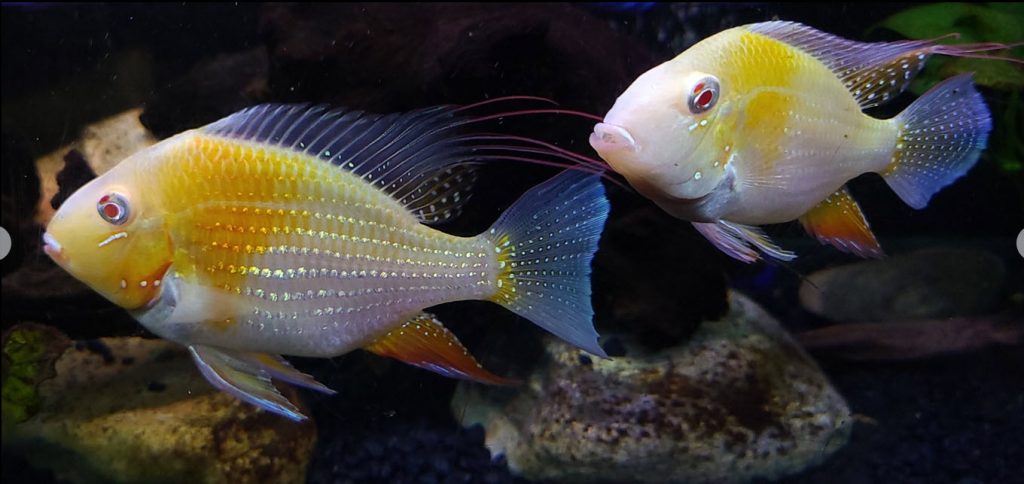
Bio-Wheel Hang-on-back Filters
Bio-wheels are an interesting step up from most back to front flow HOB filters. They are HOB filters that have had a pleated fibrous polyester media wheel added, which rotates in the flow of the water out the filter. They run $40 to $85 and process 200 to 400 gph. The bio-wheel serves to aerate the water a little bit. This is a decent addition for a HOB filter and adds a little bit better aeration to the mix for HOBs.
Bio-wheels also do a slightly better job in bio-filtration than a HOB with just a cartridge. But bio-wheels do not significantly improve the function of a hang-on-back filter. And bio-wheels frequently stick and refuse to turn.
.
Return to Filter Menu
Aquarium Science Website
The chapters shown below or on the right side in maroon lead to close to 400 articles on all aspects of keeping a freshwater aquarium. These articles have NO links to profit making sites and are thus unbiased in their recommendations, unlike all the for-profit sites you will find with Google. Bookmark and browse!
.

Dave says
In reply to Cody …… It is beneficial bacteria. Just leave it be till the flow slows down.
Cody Gray says
Hi Dave I’m running an aquaclear 110 and an aquaclear 70 on the back of my 29 gallon. Both are filled with only bio foam and I haven’t cleaned the fact am for months. I have a question though (wish i could include a picture for reference). All my foam when I pull the media tray out is brown, and inside the pores looks brown and I’m assuming that’s BB, but on the top piece of foam on the top outer surface is brown gunk and I am wondering is that more BB or is that just waste that has collected?
Dave says
In reply to Maeve …. Sorry, I’ve never run across anything pictorial or video on the subject. And I’ve never done it myself. Basically it would entail simply emptying the HOB of all media and cartridges, filing the HOB with 60% by volume micro K1, putting a “top” piece of mesh to prevent overflow of the K1, and plop in an operating air stone.
Maeve says
Hi. I’m a very visual learner. Is there a video you can recommend for making hob a fluidized bed? Or could you possibly do a post with photos for each step? My neurodivergence makes written instructions without pictures almost impossible for me.
Thank you so much for all the incredible research backed info on this website. I appreciate it so much!
Dave says
In reply to Kingston …. There are no hang on backs that have a 1.25″ lip. So you have to go to a sump, canister and/or undergravel filter. All three are much better filters than any hang-on-back.
Kingston Wong says
All my tanks are Oceanic aquariums. The top lips are 1.25″ or 32mm. None of the current Hang-on-the-back filters fit. The filter gap is only 1″ or 25mm. The filters will not even go over the lip. I currently use the old Marineland 250 (Hot Magnum) filters in my tanks. My 100gals run 4 filters each. Over the years the impellers would break, but I would just buy new ones, unfortunately the impellers are no longer available. Is there a Hang on that will fit over a 1.25″ lip??